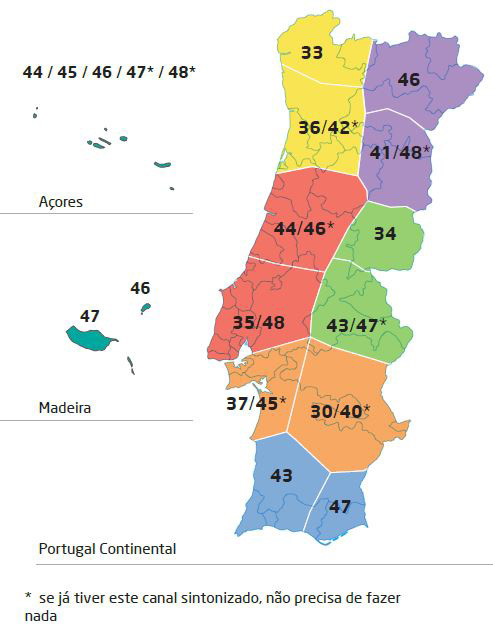An english version of this page will be made available soon.
You may wish to go to the english homepage.
You may wish to go to the english homepage.
Decision (EU) 2017/899https://www.anacom.pt/render.jsp?contentId=1410359 of the European Parliament and of the Council, of 17 May, concerning the use of the 470-790 MHz frequency band within the Union, states that “with effect from 30 June 2020, Member States shall allow the use of the 694-790 MHz (“700 MHz”) frequency band for terrestrial systems capable of providing broadband wireless electronic communications services.
This implies that, in Portugal, as well as in other European countries, this band will be released from its current use for digital terrestrial television (DTT).
Once the 700 MHz band has been released, it will be made available for the provision of terrestrial wireless broadband electronic communications services, namely 5th generation (5G) mobile technology, which will enable the development of the country, its economy and an improvement in the quality of life of citizens.
The migration of the digital terrestrial television (DTT) network, which broadcasts RTP1, RTP2, RTP3, RTP Memória, SIC, TVI and Canal Parlamento, involved change the frequencies of the broadcasters using the 694-790 MHz frequency band (the “700 MHz band”) to new broadcasting frequencies.
This change is due to the fact that the “700 MHz band” has to be freed up by 30 June 2020 to be made available for the provision of terrestrial wireless broadband electronic communications services.
The changes of frequency of the digital terrestrial television (DTT) network broadcasters were phased in. It began on 7 February 2020 with the resynchronisation of the Sines transmitter. And continued in the south of the country, then move north and end in the autonomous regions of Azores and the Madeira. These network changes, suspended on March 13 due to the constraints associated to COVID-19https://www.anacom.pt/render.jsp?contentId=1520230, have been resumed on August 12 with a new migration schedule for DTT broadcastershttps://www.anacom.pt/render.jsp?contentId=1555501.
Stages of channel change in the rest of the country

* The channels in these zones are already in operation and therefore need not be changed.
Region 1 | |
Region 2 | |
Region 3 | |
Region 4 | |
Region 5 | Beginning of the migration process on a date to be defined |
Region 6 | Beginning of the migration process on a date to be defined |
Region A | Beginning of the migration process on a date to be defined |
Region M | Beginning of the migration process on a date to be defined |
This process will not have any impact on digital terrestrial television (DTT) users, in particular those who already have equipment tuned to channels 40, 42, 45, 46, 47 and 48, corresponding to frequencies below 700 MHz, given that these will not be subject to any change.
Users who will be impacted by this frequency change process are those who have the equipment tuned to one of the around 240 broadcasters using radio channels 49, 54, 55 or 56, corresponding to frequencies above 700 MHz, who will have to re-tune their TV or TDT box using the respective controls.
It should be noted that it will not be necessary to purchase new reception antennas, nor to change TV or DTT box. There will also be no need to realign receiving antennas (the transmitters will remain in the same place).
No one will have to subscribe to pay-TV services (TV packages) either, as everyone will be able to continue to watch free TV, as per current practice.
We underline that the only thing required where TV reception is lost, and a black screen appears, is to tune the TV or DTT box to the new channel.
We also warn DTT users to remain vigilant and to report any attempts by third parties to induce them into purchasing equipment or subscribing to pay-TV services using the fraudulent argument that this is necessary in view of the forthcoming change of DTT frequencies.
TV/box re-tuning must be performed by all users currently receiving digital terrestrial television (DTT) through broadcasters using radio channels 49, 54, 55 or 56, corresponding to frequencies above 700 MHz.
This migration will not affect:
No. You do not need to change your television or add or change external decoders (boxes) to continue receiving full digital terrestrial television (DTT) programming.
However, buildings or condominiums that use mono-channel amplifiers in their signal amplification and distribution systems may need to replace them.
The digital terrestrial television (DTT) migration process may require the adaptation of collective receiving infrastructure in buildings. This adaptation will not be the same for everyone, depending on the type of infrastructure used in the buildings.
So if your building's receiving installation has:
Saiba mais sobre a tipificação das instalações de receção TDT (Learn more about the types of DTT receiving facilities).
The entity in charge of the change of frequencies in digital terrestrial television (DTT) broadcasters is MEO - Serviços de Comunicações e Multimédia, since this was the entity that installed and operates the DTT network, also being, as such, the entity in charge of the changes that will be made.
If you are in an area served by the frequency-changing broadcasters, and if you do not retune, you will no longer receive the digital terrestrial television (DTT) signal.